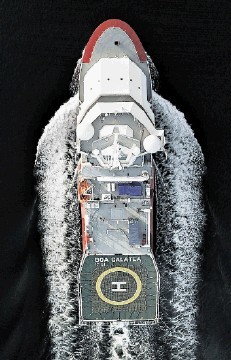
EMGS (ElectroMagnetic GeoServices) of Norway returned to profit during Q3 this year, lifted by record productivity from a vessel working for Pemex in the Mexican sector of the Gulf of Mexico.
The company, which earlier this year acquired competitor Offshore Hydrocarbon Mapping (OHM) of Aberdeen, turned a net income of $7.5million in the latest quarter versus a $8.3million loss for the same period last year. Revenue doubled to $45.5million.
The big lift primarily came from earnings of $25.5million pulled in by the BOA Thalassa survey vessel, which has set a new productivity benchmark whilst on the Pemex charter.
The company’s EBIDTA (earnings before interest deductions and tax allowances) earnings rose year-on-year to $11.9million from $6.million.
EMGS has been raking in the revenues thanks to a string of contract wins:
A $90million award from Petrobras for work off Brazil
A $5.5million contract offshore Ghan
A multi-client 3D magneto-telluric (MT) survey in the Norwegian Sea, for which it has received pre-funding from ExxonMobil.
The $15.75million takeover of OHM Survey has given EMGS access to two additional vessels that can be deployed from Bergen and Singapore as required.
One, the former OHM vessel, OHM Express, renamed EM Express, will be used for this survey.
EMGS believes its pioneering work with MT methods will have a particular advantage in determining the thickness of the basalt layers that may mask sediments harbouring hydrocarbons. EMGS now sees revenue for the full year at close to $160million, up from its prior estimate of $150million.
Meanwhile, the International Association of Geophysical Contractors (IAGC) has disclosed that an environmental impact assessment of electromagnetic (EM) techniques used for oil and gas exploration and production in the marine environment has “no potential for significant effects” on sea life.
At least that is the current view of the US Department of Energy’s EIA (Energy Information Administration).
EM survey technologies currently in use offshore employ an electric dipole antenna (source) towed behind a vessel. The electric and magnetic fields – either natural or subsequently induced in the subsurface – are measured and recorded by an array of receivers.
To date, these receivers have usually been deployed on the seafloor then retrieved to process the measurements. However, tests are currently being conducted to commercialise a system that enables receivers to be towed underwater behind a ship, much like the approach used for marine seismic.
The administration has come to the conclusion that EM sources as presently used have no potential for significant effects on animal groups such as fish, seabirds, sea turtles, and marine mammals.
In addition, cumulative effects from EM surveys are deemed negligible compared to natural EM anomalies, induced fields from natural water currents, and anthropogenic EM sources such as those originating from undersea equipment.